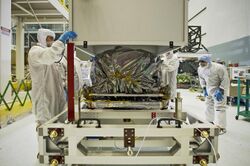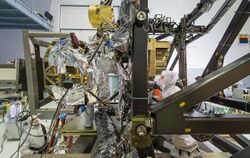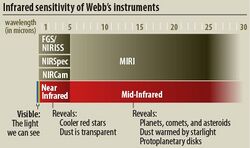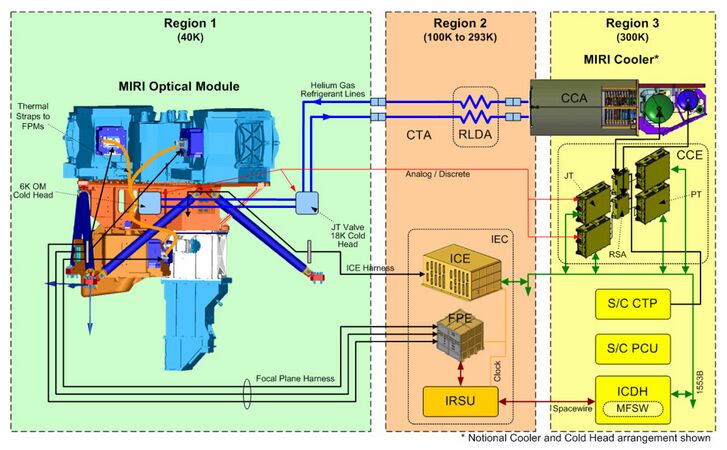Engineering:MIRI (Mid-Infrared Instrument)

MIRI, or Mid-Infrared Instrument, is an instrument on the James Webb Space Telescope.[1] MIRI is a camera and a spectrograph that observes mid to long infrared radiation from 5 to 28 microns.[1] It also has coronagraphs, especially for observing exoplanets.[2] Whereas most of the other instruments on Webb can see from the start of near infrared, or even as short as orange visible light, MIRI can see longer wavelength light.[1]
MIRI uses silicon arrays doped with arsenic to make observations at these wavelengths.[1] The imager is designed for wide views but the spectrograph has a smaller view.[1] Because it views the longer wavelengths it needs to be cooler than the other instruments (see Infrared astronomy), and it has an additional cooling system.[1] The cooling system for MIRI includes a Pulse Tube precooler and a Joule-Thomson Loop heat exchanger.[1] This allowed MIRI to be cooled down to a temperature of 7 kelvins during operations in space.[1]
Overview
The spectrograph can observe wavelengths between 4.6 and 28.6 microns, and it has four separate channels, each with its own gratings and image slicers.[2] The field of view of the spectrograph is 3.5 by 3.5 arcseconds.[2]
The imager has a plate scale of 0.11 arcseconds/pixel and a field of view of 74 by 113 arcseconds.[3] Earlier in development the field of view was going to be 79 by 102 arcseconds (1.3 by 1.7 arcmin).[2] The imaging channel has ten filters available and the detectors are made of arsenic-doped silicon (Si:As).[1] The detectors (one for the imager, and two for the spectrometer) each have a resolution of 1024x1024 pixels, and they are called Focal Plane Modules or FPMs.[4]
During 2013 and finishing in January 2014, MIRI was integrated into the Integrated Science Instrument Module (ISIM).[5] MIRI successfully passed Cryo Vac 1 and Cryo Vac 2 tests as part of ISIM in the 2010s.[5] MIRI was developed by an international consortium.[5]
MIRI is attached to the ISIM by a carbon-fiber and plastic hexapod structure, which attaches it to the spacecraft but also helps thermally isolate it.[1] (see also Carbon fiber reinforced plastic)
Parts summary:[6]
- Spectrometer optics
- Focal Plane Arrays
- Input-Optics Calibration Module (IOC)[4]
- CFRP hexapod
- Imager
- Image slicers
- Deck
Most of MIRI is located in the main ISIM structure, however the cryocooler is in region 3 of ISIM which is located in the spacecraft bus.[7]
The imager module of MIRI also includes the Low Resolution Spectrometer that can perform long-slit and slitless spectroscopy from 5 to 12 μm light wavelength.[8] The LRS uses Ge (germanium metal) and ZnS (zinc sulfide) prisms to cause spectroscopic dispersion.[8]
Commissioning is complete as of the following dates:
- Imaging, 06/17/2022
- Low resolution spectroscopy, 06/24/2022
- Medium resolution spectroscopy, 06/24/2022
- Coronagraphic imaging, 06/29/2022
Cryocooler
To allow mid-infrared observations within the JWST, the MIRI instrument has an additional cooling system. It works roughly similar to how most refrigerators or an air-conditioner works: a fluid is brought down to a cold temperature in the warm section, and sent back to the cold section where it absorbs heat, then it goes back to the condenser. One source of heat is the left-over heat of the spacecraft, but another is the spacecraft's own electronics, some of which are close to the actual instruments to process data from observations. Most of the electronics are in the much warmer spacecraft bus, but some of the electronics needed to be much closer, and great lengths were taken to reduce the heat they produce. By reducing how much heat the electronics make on the cold side, then less heat needs to be removed.
In this case the JWST cryocooler resides in the spacecraft bus and it has lines of coolant that run to the MIRI instrument, chilling it. The cryocooler has a heat radiator on the spacecraft bus to emit the heat it collects.[9] In this case the cooling system uses helium gas as the refrigerant.
The JWST cryocooler is based originally on the TRW ACTDP cryocooler.[9] However, the JWST has had to develop a version to handle higher thermal loads.[10] It has a multi-stage pulse tube refrigerator that chills an even more powerful cooler.[9] That is a linear-motion Oxford-style compressor that powers a J-T loop.[10] Its target is to cool the MIRI instrument down to 6 kelvins (−448.87 °F, or −267.15 °C).[9] The ISIM is at about 40 K (due to the sunshield) and there is a dedicated MIRI radiation shield beyond which the temperature is 20 K.[9] The J-T loop is a Joule–Thomson loop heat exchanger.[1]
Filters
MIRI has 10 filters available for observations.[11]
- F560W - Broadband Imaging
- F770W - PAH, broadband imaging
- F1000W - Silicate, broadband imaging
- F1130W - PAH, broadband imaging
- F1280W - Broadband imaging
- F1500W - Broadband imaging
- F1800W - Silicate, broadband imaging
- F2100W - Broadband imaging
- F2550W - Broadband imaging
- F2550WR - Redundant filter, risk reduction
- FND - For bright target acquisition
- Opaque - Darks
Diagrams
See also
- Spitzer Space Telescope (NASA's mid-infrared space telescope launched in 2003, it could not see as deep into the infrared when its coolant supply was depleted in 2009)
- Wide-field Infrared Survey Explorer (infrared survey telescope)
- List of largest infrared telescopes (includes examples of space observatories that have designed for similar wavelengths)
- Jovian Infrared Auroral Mapper (IR Imaging spectrometer on Juno Jupiter orbiter)
- Infrared Array Camera (Spitzer near to mid infrared camera)
References
- ↑ 1.00 1.01 1.02 1.03 1.04 1.05 1.06 1.07 1.08 1.09 1.10 "The James Webb Space Telescope". http://jwst.nasa.gov/miri.html. Retrieved 5 December 2016.
- ↑ 2.0 2.1 2.2 2.3 "MIRI - the mid-infrared instrument on JWST". http://sci.esa.int/jwst/46826-miri-the-mid-infrared-instrument-on-jwst/. Retrieved 5 December 2016.
- ↑ Bouchet, Patrice; García-Marín, Macarena; Lagage, P.-O.; Amiaux, Jérome; Auguéres, J.-L.; Bauwens, Eva; Blommaert, J. A. D. L.; Chen, C. H. et al. (2015). "The Mid-Infrared Instrument for the James Webb Space Telescope, III: MIRIM, the MIRI Imager". Publications of the Astronomical Society of the Pacific 127 (953): 612–622. doi:10.1086/682254.
- ↑ 4.0 4.1 4.2 4.3 4.4 4.5 4.6 "Instrument". http://ircamera.as.arizona.edu/MIRI/instrument.htm. Retrieved 5 December 2016.
- ↑ 5.0 5.1 5.2 "MIRI - Mid Infrared Instrument". http://www.stsci.edu/jwst/instruments/miri. Retrieved 5 December 2016.
- ↑ "MIRI for JWST". http://ircamera.as.arizona.edu/MIRI/. Retrieved 5 December 2016.
- ↑ NASA JWST Integrated Science Instrument Module (ISIM - Accessed December 12, 2016]
- ↑ 8.0 8.1 http://ircamera.as.arizona.edu/MIRI/paper4.pdf [bare URL PDF]
- ↑ 9.0 9.1 9.2 9.3 9.4 "6K MIRI Cryocooler". http://www2.jpl.nasa.gov/adv_tech/coolers/ACTDP_MIRI.htm.
- ↑ 10.0 10.1 "6K MIRI Cryocooler". http://www2.jpl.nasa.gov/adv_tech/coolers/ACTDP_MIRI.htm.
- ↑ "MIRI Filters and Dispersers - JWST User Documentation". https://jwst-docs.stsci.edu/jwst-mid-infrared-instrument/miri-instrumentation/miri-filters-and-dispersers.
External links
- ESA - MIRI - the mid-infrared instrument on JWST
- Presentation on MIRI's coronographs (.pdf)
- The Mid-Infrared Instrument for JWST, II: Design and Build - Wright, et al (long paper on Miri)
- MIRI Encyclopedia at University of Arizona
- NASA - JWST Cryocooler










